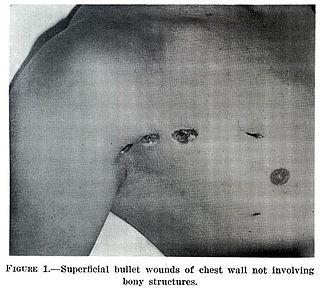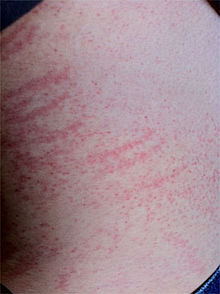
Dermatitis is inflammation of the skin, typically characterized by itchiness, redness and a rash. In cases of short duration, there may be small blisters, while in long-term cases the skin may become thickened. The area of skin involved can vary from small to covering the entire body. Dermatitis is often called eczema, and the difference between those terms is not standardized.

A wound is a rapid onset of injury that involves lacerated or punctured skin, or a contusion from blunt force trauma or compression. In pathology, a wound is an acute injury that damages the epidermis of the skin. To heal a wound, the body undertakes a series of actions collectively known as the wound healing process.

Lichen simplex chronicus (LSC) is thick leathery skin with exaggerated skin markings caused by sudden itching and excessive rubbing and scratching. It generally results in small bumps, patches, scratch marks and scale. It typically affects the neck, scalp, upper eyelids, ears, palms, soles, ankles, wrists, genital areas and bottom. It often develops gradually and the scratching becomes a habit.

Contact dermatitis is a type of acute or chronic inflammation of the skin caused by exposure to chemical or physical agents. Symptoms of contact dermatitis can include itchy or dry skin, a red rash, bumps, blisters, or swelling. These rashes are not contagious or life-threatening, but can be very uncomfortable.

A skin condition, also known as cutaneous condition, is any medical condition that affects the integumentary system—the organ system that encloses the body and includes skin, nails, and related muscle and glands. The major function of this system is as a barrier against the external environment.
Sclerodactyly is a localized thickening and tightness of the skin of the fingers or toes that yields a characteristic claw-like appearance and spindle shape of the affected digits, and renders them immobile or of limited mobility. The thickened, discolored patches of skin are called morphea, and may involve connective tissue below the skin, as well as muscle and other tissues. Sclerodactyly is often preceded by months or even years by Raynaud's phenomenon when it is part of systemic scleroderma.

Eczema herpeticum is a rare but severe disseminated infection that generally occurs at sites of skin damage produced by, for example, atopic dermatitis, burns, long-term usage of topical steroids or eczema. It is also known as Kaposi varicelliform eruption, Pustulosis varioliformis acute and Kaposi–Juliusberg dermatitis.

Prurigo nodularis (PN), also known as nodular prurigo, is a skin disease characterised by pruritic (itchy) nodules which usually appear on the arms or legs. Patients often present with multiple excoriated lesions caused by scratching. PN is also known as Hyde prurigo nodularis, Picker's nodules, atypical nodular form of neurodermatitis circumscripta, lichen corneus obtusus.

Acrokeratoelastoidosis of Costa or Acrokeratoelastoidosis is a hereditary form of marginal keratoderma, and can be defined as a palmoplantar keratoderma. It is distinguished by tiny, firm pearly or warty papules on the sides of the hands and, occasionally, the feet. It is less common than the hereditary type of marginal keratoderma, keratoelastoidosis marginalis.
Adrenergic urticaria is a skin condition characterized by an eruption consisting of small (1-5mm) red macules and papules with a pale halo, appearing within 10 to 15 min after emotional upset. There have been 10 cases described in medical literature, and involve a trigger followed by a rise in catecholamine and IgE. Treatment involves propranolol and trigger avoidance.
Acral persistent papular mucinosis (APPM) is a rare form of lichen myxedematosus. It is characterized by small papules on the backs of the hands, wrists, and extensor aspects of the distal forearms, with no further clinical or laboratory indications. Lesions tend to persist and may grow in number gradually. Because there are no symptoms, treatment is rarely required.

Acute hemorrhagic edema of infancy (AHEI) is a type of leukocytoclastic vasculitis that is not fatal. Although it causes fever, large palpable purpuric skin lesions, and edema, it is a harmless condition. AHEI's appearance is frequently similar to that of Henoch-Schönlein purpura. Because AHEI is a self-limiting disease, conservative treatment is common.

Eccrine carcinoma is a rare skin condition characterized by a plaque or nodule on the scalp, trunk, or extremities. It originates from the eccrine sweat glands of the skin, accounting for less than 0.01% of diagnosed cutaneous malignancies. Eccrine carcinoma tumors are locally aggressive, with a high rate of recurrence. Lack of reliable immunohistochemical markers and similarity to other common tumors has made identification of eccrine carcinoma difficult.
Pseudocyst of the auricle is a cutaneous condition characterized by a fluctuant, tense, noninflammatory swelling on the upper half of the ear, known as the auricle or pinna. It is called a "pseudocyst" because it is not a true cyst, but rather a collection of fluid or blood trapped within the tissue layers of the auricle.
Lepidopterism is an irritant contact dermatitis caused by irritating caterpillar or moth hairs coming into contact with the skin or mucosa. When referring to the cause, moth dermatitis and caterpillar dermatitis are commonly used; Caripito itch is an older name referring to the moth dermatitis caused by some Hylesia species.
Fiddler's neck is an occupational disease that affects violin and viola players.
Maskne is a portmanteau of "mask" and "acne". The term appeared in use during the COVID-19 pandemic in 2020 to refer to acne and other rashes of the face that occur in association with mask wearing. The findings are observational only and related to pressure, occlusion and friction. It is likely that several are perioral dermatitis, rosacea, seborrheic dermatitis, folliculitis, irritant contact dermatitis or allergic contact dermatitis, and acne mechanica. In one article, maskne is observed to be caused by increase of humidity in the occluded area and sebum being secreted, increasing the amount of squalene on the skin. This, along with excess sweating lead to the swelling of epidermal keratinocytes, causing acute obstruction and acne aggravation. The hot and humid environment in which maskne is induced is also apparent with tropical acne. The best treatment for maskne is to avoid wearing a mask.

Dermatoses induced by Personal Protective Equipment are skin lesions that occur due to the use of personal protective equipment (PPE). Personal Protective Equipment such as masks, face shields, goggles, gloves and gowns can cause abrasion in the skin and retain moisture in body parts, particularly the face. During the COVID-19 pandemic, healthcare workers and general public need to use personal protective equipment, sometimes for extended duration, which may result in skin problems due to friction, pressure, long-term sealing and moisture retention.
Cutaneous manifestations of COVID-19 are characteristic signs or symptoms of the Coronavirus disease 2019 that occur in the skin. The American Academy of Dermatology reports that skin lesions such as morbilliform, pernio, urticaria, macular erythema, vesicular purpura, papulosquamous purpura and retiform purpura are seen in people with COVID-19. Pernio-like lesions were more common in mild disease while retiform purpura was seen only in critically ill patients. The major dermatologic patterns identified in individuals with COVID-19 are urticarial rash, confluent erythematous/morbilliform rash, papulovesicular exanthem, chilbain-like acral pattern, livedo reticularis and purpuric "vasculitic" pattern. Chilblains and Multisystem inflammatory syndrome in children are also cutaneous manifestations of COVID-19.











